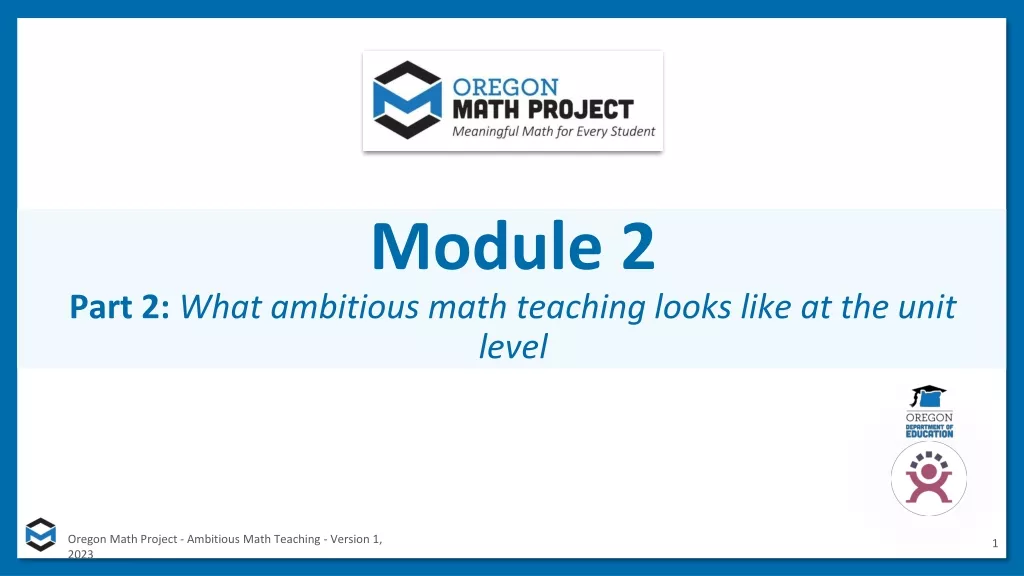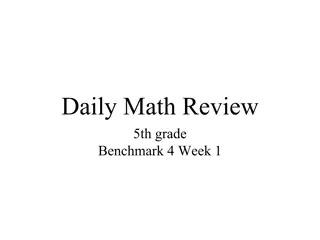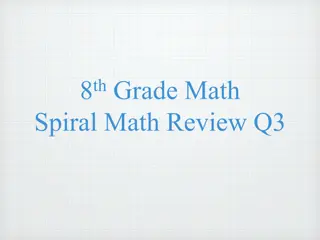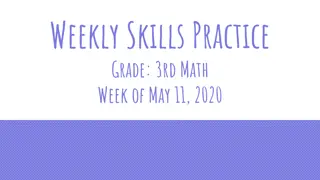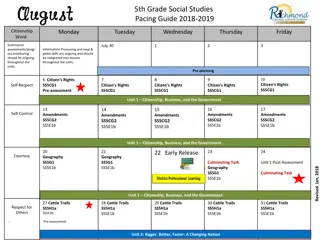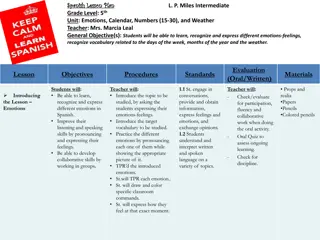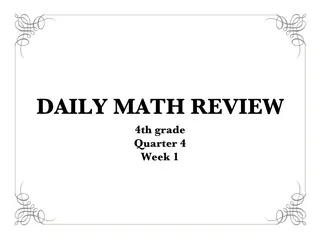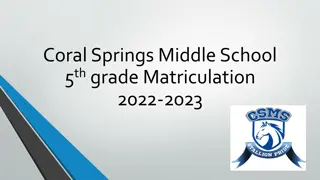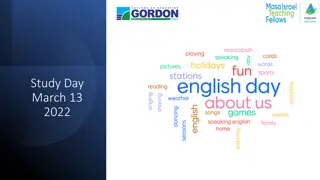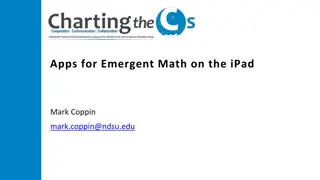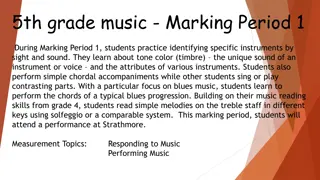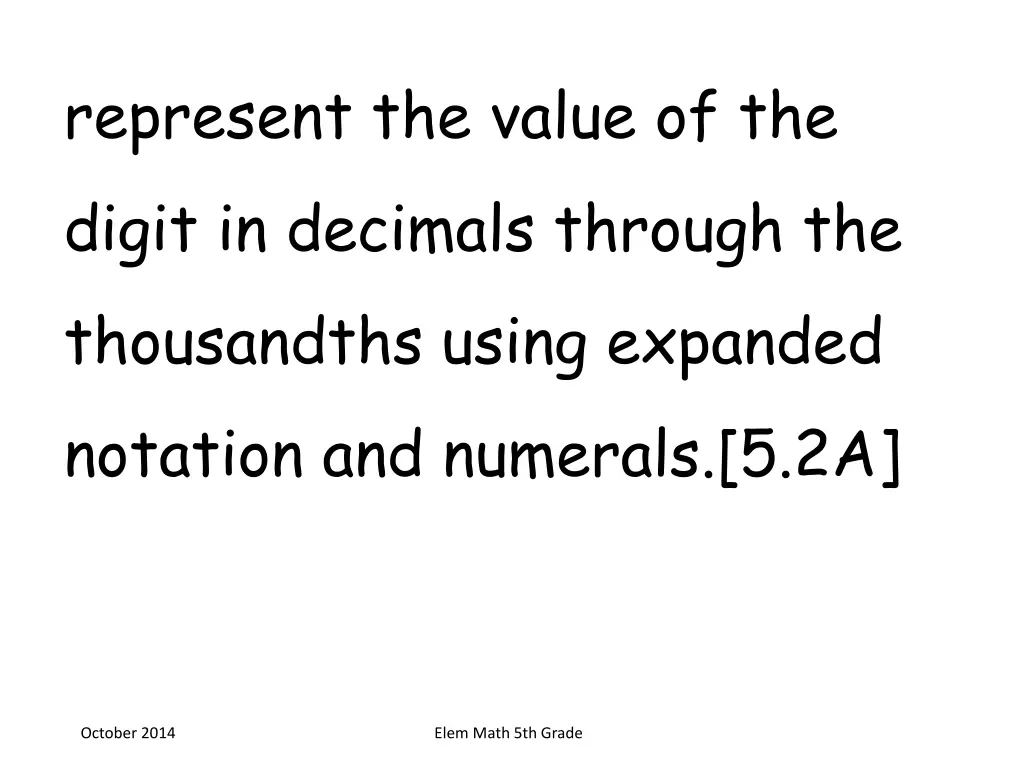
Understanding Decimals through Thousandths in Elementary Math
Explore concepts such as representing decimal values through expanded notation, comparing and ordering decimals to the thousandths place, rounding decimals, estimating solutions, multiplying decimals, solving for quotients with proficiency, and more in elementary math.
Download Presentation

Please find below an Image/Link to download the presentation.
The content on the website is provided AS IS for your information and personal use only. It may not be sold, licensed, or shared on other websites without obtaining consent from the author. If you encounter any issues during the download, it is possible that the publisher has removed the file from their server.
You are allowed to download the files provided on this website for personal or commercial use, subject to the condition that they are used lawfully. All files are the property of their respective owners.
The content on the website is provided AS IS for your information and personal use only. It may not be sold, licensed, or shared on other websites without obtaining consent from the author.
E N D
Presentation Transcript
represent the value of the digit in decimals through the thousandths using expanded notation and numerals.[5.2A] October 2014 Elem Math 5th Grade
compare and order two decimals to thousandths and represent comparisons using the symbols >, <, or =.[5.2B] October 2014 Elem Math 5th Grade
round decimals to tenths or hundredths.[5.2C] October 2014 Elem Math 5th Grade
estimate to determine solutions to mathematical and real-world problems involving addition, subtraction, multiplication, or division. [5.3A] October 2014 Elem Math 5th Grade
multiply with fluency a three- digit number by a two-digit number using the standard algorithm.[5.3B] October 2014 Elem Math 5th Grade
solve with proficiency for quotients of up to a four-digit dividend by a two-digit divisor using strategies and the standard algorithm.[5.3C] October 2014 Elem Math 5th Grade
represent multiplication of decimals with products to the hundredths using objects and pictorial models, including area models.[5.3D] October 2014 Elem Math 5th Grade
solve for products of decimals to the hundredths, including situations involving money, using strategies based on place-value understandings, properties of operations, and the relationship to the multiplication of whole numbers.[5.3E] October 2014 Elem Math 5th Grade
represent quotients of decimals to the hundredths, up to four- digit dividends and two-digit whole number divisors, using objects and pictorial models, including area models.[5.3F] October 2014 Elem Math 5th Grade
solve for quotients of decimals to the hundredths, up to four-digit dividends and two-digit whole number divisors, using strategies and algorithms, including the standard algorithm.[5.3G] October 2014 Elem Math 5th Grade
represent and solve addition and subtraction of fractions with unequal denominators referring to the same whole using objects and pictorial models and properties of operations.[5.3H] October 2014 Elem Math 5th Grade
represent and solve multiplication of a whole number and a fraction that refers to the same whole using objects and pictorial models, including area models.[5.3I] October 2014 Elem Math 5th Grade
represent division of a unit fraction by a whole number and the division of a whole number by a unit fraction such as 1/3 7 and 7 1/3 using objects and pictorial models, including area models.[5.3J] October 2014 Elem Math 5th Grade
add and subtract positive rational numbers fluently.[5.3K] October 2014 Elem Math 5th Grade
divide whole numbers by unit fractions and unit fractions by whole numbers.[5.3L] October 2014 Elem Math 5th Grade
identify prime and composite numbers.[5.4A] October 2014 Elem Math 5th Grade
represent and solve multi-step problems involving the four operations with whole numbers using equations with a letter standing for the unknown quantity.[5.4B] October 2014 Elem Math 5th Grade
generate a numerical pattern when given a rule in the form y = ax or y = x + a and graph. [5.4C] October 2014 Elem Math 5th Grade
recognize the difference between additive and multiplicative numerical patterns given in a table or graph.[5.4D] October 2014 Elem Math 5th Grade
describe the meaning of parentheses and brackets in a numeric expression.[5.4E] October 2014 Elem Math 5th Grade
simplify numerical expressions that do not involve exponents, including up to two levels of grouping.[5.4F] October 2014 Elem Math 5th Grade
use concrete objects and pictorial models to develop the formulas for the volume of a rectangular prism, including the special form for a cube (V = l x w x h, V = s x s x s, and V = Bh).[5.4G] October 2014 Elem Math 5th Grade
represent and solve problems related to perimeter and / or area and related to volume.[5.4H] October 2014 Elem Math 5th Grade
classify two-dimensional figures in a hierarchy of sets and subsets using graphic organizers based on their attributes and properties. [5.5A] October 2014 Elem Math 5th Grade
recognize a cube with side length of one unit as a unit cube having one cubic unit of volume and the volume of a three-dimensional figure as the number of unit cubes (n cubic units) needed to fill it with no gaps or overlaps if possible.[5.6A] October 2014 Elem Math 5th Grade
determine the volume of a rectangular prism with whole number side lengths in problems related to the number of layers times the number of unit cubes in the area of the base.[5.6B] October 2014 Elem Math 5th Grade
solve problems by calculating conversions within a measurement system, customary or metric.[5.7A] October 2014 Elem Math 5th Grade
describe the key attributes of the coordinate plane, including perpendicular number lines (axes) where the intersection (origin) of the two lines coincides with zero on each number line and the given point (0, 0); the x-coordinate, the first number in an ordered pair, indicates movement parallel to the x-axis starting at the origin; and the y-coordinate, the second number, indicates movement parallel to the y- axis starting at the origin.[5.8A] October 2014 Elem Math 5th Grade
describe the process for graphing ordered pairs of numbers in the first quadrant of the coordinate plane.[5.8B] October 2014 Elem Math 5th Grade
graph in the first quadrant of the coordinate plane ordered pairs of numbers arising from mathematical and real-world problems, including those generated by number patterns or found in an input-output table. [5.8C] October 2014 Elem Math 5th Grade
represent categorical data with bar graphs or frequency tables and numerical data, including data sets of measurements in fractions or decimals, with dot plots or stem- and-leaf plots.[5.9A] October 2014 Elem Math 5th Grade
represent discrete paired data on a scatterplot.[5.9B] October 2014 Elem Math 5th Grade
solve one- and two-step problems using data from a frequency table, dot plot, bar graph, stem-and-leaf plot, or scatterplot.[5.9C] October 2014 Elem Math 5th Grade
define income tax, payroll tax, sales tax, and property tax. [5.10A] October 2014 Elem Math 5th Grade
explain the difference between gross income and net income.[5.10B] October 2014 Elem Math 5th Grade
identify the advantages and disadvantages of different methods of payment, including check, credit card, debit card, and electronic payments. [5.10C] October 2014 Elem Math 5th Grade
develop a system for keeping and using financial records. [5.10D] October 2014 Elem Math 5th Grade
describe actions that might be taken to balance a budget when expenses exceed income. [5.10E] October 2014 Elem Math 5th Grade
balance a simple budget. [5.10F] October 2014 Elem Math 5th Grade

